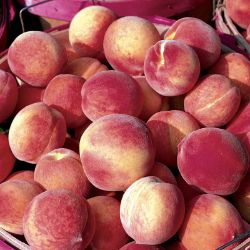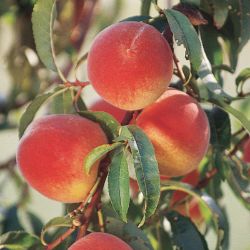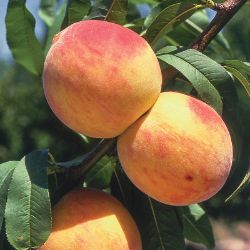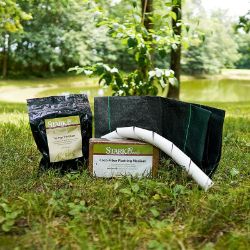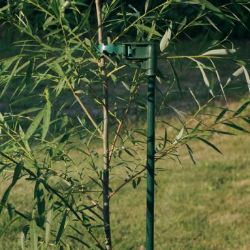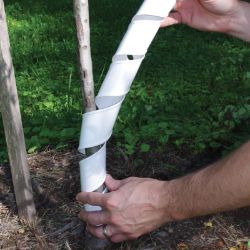Fertilizing Peach Trees
Fertilizing is an excellent way to replenish the nutrients in your soil, especially nitrogen. Nitrogen encourages green vegetative growth, which is exactly what you want to promote before your peach tree reaches its fruit-bearing years.
NOTE: This is part 6 in a series of 11 articles. For a complete background on how to grow peach trees, we recommend starting from the beginning.
Always test your soil prior to applying any fertilizers. Different soils can have varying amounts of native elements needed to support peach tree health and development. If you discover your soil lacks any necessary nutrients (nitrogen, phosphates, potash, etc.), be sure to choose a fertilizer that supplements the soil’s nutrient deficiency.
Get to know your soil and discover the importance of soil testing prior to making any changes.
About Fertilizer
Fertilizers — both synthetic and organic (naturally derived) — are soil amendments labeled with a “guaranteed analysis” of nutrients like Nitrogen (N), Phosphate (P), and Potash (K).
Alternately, there are organic soil amendments, like compost and aged/rotted manure. They are applied like fertilizers, but they are not technically fertilizers. You can make your own organic soil amendments, like compost from food or garden scraps, or even find compost, manure, and other organic soil amendments from a trusted local source. While these help add nutrients to the soil to support your peach trees, they will not have a “guaranteed analysis” value.
In general, peach trees thrive when macronutrients like Nitrogen (N), Phosphorous (P), and Potassium (K) are present. Nitrogen helps encourage vegetative growth (leaves and branches). Phosphorus encourages root and blossom development. Potassium/Potash is responsible for the peach tree’s natural disease-resistance and systems supporting its overall health, kind of like an immune system. Our water-soluble Stark® Tre-Pep® Fertilizer is specially formulated for use on young peach trees (and all young fruit trees), because it provides the nutrients these young trees take in during their first years in the ground. More established trees benefit from a focused nutrient supplement like Stark® Orchard Fertilizer.
Macronutrients
Nitrogen, phosphorus, potassium, sulfur, calcium, and magnesium are the “big” macro-nutrients peach trees need to grow normally. They are present in healthy soil, but may be added when soil is deficient. Nitrogen is the nutrient most used by growing peach trees; it moves throughout the soil, is leached off by normal growth and must be replaced by synthetic or organic compounds. The main source of nitrogen is decaying organic matter. Signs of macronutrient deficiency in peach trees include reddish or pale colored leaves, narrow or shrunken leaves and round dead spots on leaves.
Micronutrients
Peach trees also need micronutrients in the soil, which help make the macronutrients available to the tree. For example, molybdenum helps fix nitrogen to the soil, and chlorine converts sunlight to food (photosynthesis). Copper and zinc prevent color mottling and misshapen leaves. The easiest way to add micronutrients is by adding aged compost or a good, balanced fruit tree fertilizer.
When to Fertilize Peach Trees
- In nutrient-rich soil (determined by a soil test), there is no need to fertilize until your peach trees begin bearing fruit (average: 2-4 years). If your new peach trees fail to put on an average of 8 to 12 inches of new green growth during the growing season, consider fertilizing the following spring.
- Typically, fertilizers are used during the growing season, as soon as the soil is workable in early spring —but stop by July 1*. Always refer to the information printed on your product’s label for specific application instructions. Be mindful that local advisories on fertilizing may be in effect during different times of year. For the sake of your local environment, please adhere to these restrictions.
- After your peach trees start bearing fruit, their uptake of nitrogen increases, so an application of high-nitrogen fertilizer is recommended once in early spring. One type of good high-nitrogen fertilizer is our Stark® Orchard Fertilizer granules.
*To avoid the chance of injury as the growing season winds down, do not fertilize later than July 1st.
Read more about fertilizing:
















